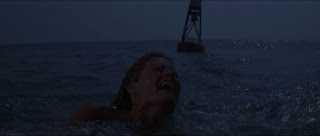As Chrissie treads water her long hair sways over her shoulders rather like the thin seaweed in the film's opening shot. The music on the soundtrack quickens as the camera approaches from below, pruriently aiming between her gently scissoring legs. There is a cut to a surface head and shoulders shot of the girl, who is smilingly unaware of the danger below. This shot is slightly raised above water level, no doubt to better record the reaction shot of first surprise then fear as she is pulled violently downwards. On the first tug Chrissie's head is jerked backwards but remains above the surface. Her initial expression - with the eyes turned downward to the right and her mouth open - is one of incomprehension. The camera cuts to a tighter close up as the second tug pulls her head violently back and under the water. When she emerges her eyes are wide with fear and she gives a series of terrified gasps. We have just time to register her reaction before she is pulled completely under for the third time. The camera remains on the disturbed water for an agonising three seconds before the girl's head erupts with a scream.
Clamped in the jaws of the unseen shark Chrissie is dragged across the width of the frame from left to right. There is a cut to another shot at water level as she is shaken from side to side like a rag doll being worried in a dog's mouth. The violent and unnatural movements of her body are in sharp contrast to the earlier graceful shots of her swimming silhouette. The water seems to be almost boiling around her, threatening to wash over the camera lens.The sounds of her screaming ('Oh God, please help me.') and the splash of the turbulent water make it almost impossible to hear the music score, which too seems to be thrashing about uncontrollably. There is a cut to an image of the boy on the beach in a posture of repose, lying on his back with his knees raised, making it clear that the girl's cries for help are going to remain unanswered. The next shot is of churning water in which only Chrissie's head and arms can be seen, flailing wildly as she cries out (somewhat unnecessarily) 'It hurts.' There is then a cut to a slightly wider shot as the girl's body is propelled across the surface of the ocean in a white plume of foam towards the buoy, which has been seen in each shot as a point of reference.
In a brief respite from the attack Chrissie clings on to the lower floatation structure, gasping, 'God, oh, God.' The bell mounted within the buoy's metal frame gives an agitated death toll as the shark comes back to take her. There is a final cut to a medium shot at water level as the girl is pulled from her mooring and dragged towards the camera. Her head is thrown back and her final screams ('Oh God, please help me.') are literally drowned out when she is pulled under for the last time. The camera holds the shot of water before cutting back to a final profile of the recumbent boy, sleeping in the sussurating surf.
The scene may not be a realistic depiction of a shark attack (as critic Gordon Gow noted in his Films and Filming review), but it is a perfectly realised visual representation of the primal fears that the film taps into. Indeed, so effective is this opening scene that none of the later attacks come anywhere near as close to its nerve-shredding intensity. After Marion Crane's shower murder in Psycho, Chrissie's demise is probably cinema's most famous watery death. There are, however, more differences than similarities between the two scenes. Although both combine voyeurism and violence, the suggestion that the character's death is a form of punishment for promiscuity is more relevant to the overall thematic design of Psycho than Jaws. One interpretation of the scene is that the shark attack is a perversely violent form of intercourse - the shark representing the phallus and the girl's screams an ugly parody of orgasm. However, there is nothing in the rest of the film to support this reading. Chrissie is just a summer girl who swims out a little far and then a shark comes along. It's true that there is a treacherous sexual undertow to Peter Benchley's original novel, but, with the exception of the mildly titillating nude shots of its opening, the movie eschews any such subtext.
The death of Christine Watkins is essentially there to kick start the story: the audience has had no time to empathise with the character with the two minutes of screen time she has been given. The brutal murder of Marion Crane, on the other hand, effectively stalls the narrative of Psycho and allows the director to transfer the audience's sympathies to the story's villain without them even realising it.
Technically, the scenes also differ. Hitchcock famously pushed the editing envelope by assembling a forty five second murder sequence out of seventy individual pieces of film. He used the appropriately named technique of cutting to create a level of violence never before put on film. Spielberg, on the other hand, uses a series of static shots in which the victim is dragged and pulled from side to side of the frame.






